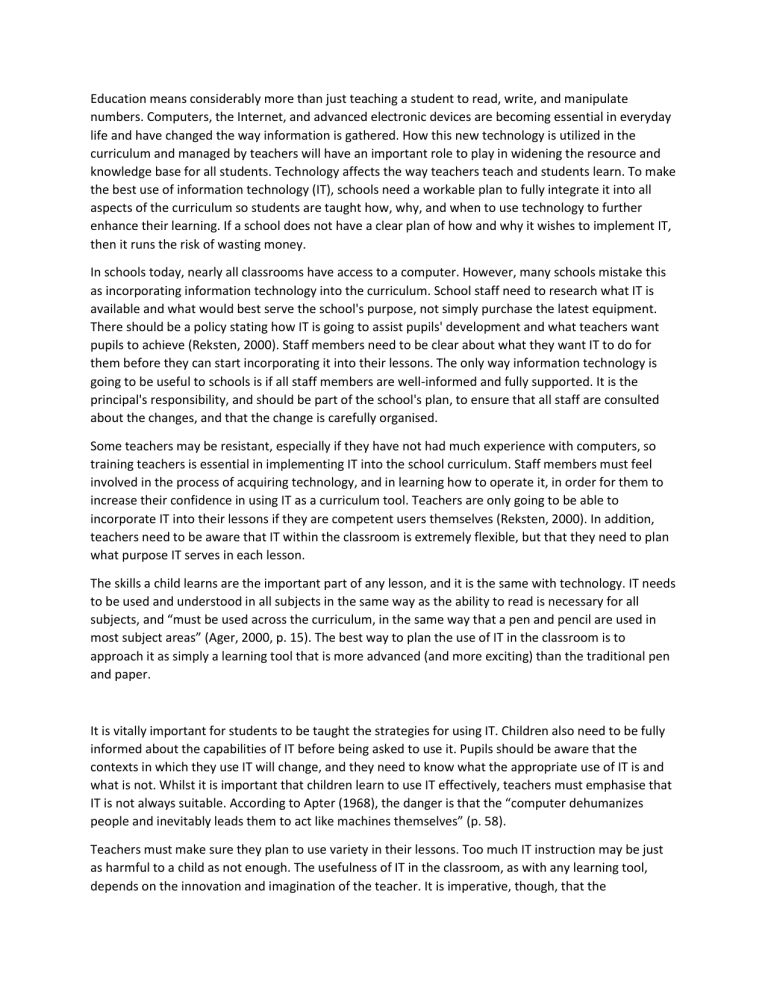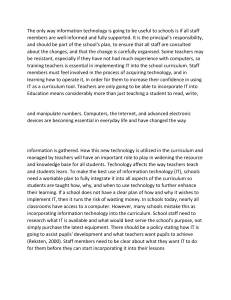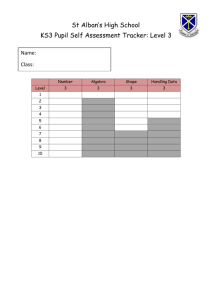
Education means considerably more than just teaching a student to read, write, and manipulate numbers. Computers, the Internet, and advanced electronic devices are becoming essential in everyday life and have changed the way information is gathered. How this new technology is utilized in the curriculum and managed by teachers will have an important role to play in widening the resource and knowledge base for all students. Technology affects the way teachers teach and students learn. To make the best use of information technology (IT), schools need a workable plan to fully integrate it into all aspects of the curriculum so students are taught how, why, and when to use technology to further enhance their learning. If a school does not have a clear plan of how and why it wishes to implement IT, then it runs the risk of wasting money. In schools today, nearly all classrooms have access to a computer. However, many schools mistake this as incorporating information technology into the curriculum. School staff need to research what IT is available and what would best serve the school's purpose, not simply purchase the latest equipment. There should be a policy stating how IT is going to assist pupils' development and what teachers want pupils to achieve (Reksten, 2000). Staff members need to be clear about what they want IT to do for them before they can start incorporating it into their lessons. The only way information technology is going to be useful to schools is if all staff members are well-informed and fully supported. It is the principal's responsibility, and should be part of the school's plan, to ensure that all staff are consulted about the changes, and that the change is carefully organised. Some teachers may be resistant, especially if they have not had much experience with computers, so training teachers is essential in implementing IT into the school curriculum. Staff members must feel involved in the process of acquiring technology, and in learning how to operate it, in order for them to increase their confidence in using IT as a curriculum tool. Teachers are only going to be able to incorporate IT into their lessons if they are competent users themselves (Reksten, 2000). In addition, teachers need to be aware that IT within the classroom is extremely flexible, but that they need to plan what purpose IT serves in each lesson. The skills a child learns are the important part of any lesson, and it is the same with technology. IT needs to be used and understood in all subjects in the same way as the ability to read is necessary for all subjects, and “must be used across the curriculum, in the same way that a pen and pencil are used in most subject areas” (Ager, 2000, p. 15). The best way to plan the use of IT in the classroom is to approach it as simply a learning tool that is more advanced (and more exciting) than the traditional pen and paper. It is vitally important for students to be taught the strategies for using IT. Children also need to be fully informed about the capabilities of IT before being asked to use it. Pupils should be aware that the contexts in which they use IT will change, and they need to know what the appropriate use of IT is and what is not. Whilst it is important that children learn to use IT effectively, teachers must emphasise that IT is not always suitable. According to Apter (1968), the danger is that the “computer dehumanizes people and inevitably leads them to act like machines themselves” (p. 58). Teachers must make sure they plan to use variety in their lessons. Too much IT instruction may be just as harmful to a child as not enough. The usefulness of IT in the classroom, as with any learning tool, depends on the innovation and imagination of the teacher. It is imperative, though, that the implementation of IT into a school is carefully planned. The current information explosion makes it essential that IT be used extensively within the classroom so children know how to use IT appropriately and effectively. Teachers must, therefore, be fully informed about what kinds of IT are available and whether or not they are appropriate for classroom use. School boards and teachers must therefore ensure that all staff have a clear plan about what they want their students to achieve through IT. The appropriate incorporation of IT into the classroom will broaden the minds and skills of students, allowing them to be better prepared for further technological advances. References Ager, R. (2000). The art of information and communications technology for teachers. David Fulton. Apter, A. J. (1968). The new technology of education. Macmillan. Reksten, L. E. (2000). Using technology to increase student learning. Corwin Press.





